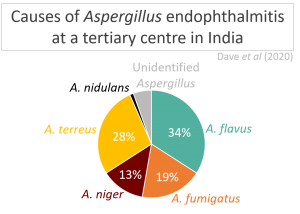Submitted by Aspergillus Administrator on 29 January 2020

Resistance to systemic antifungal medication is an increasing problem worldwide as there are very limited (i.e. three: amphotericin, azoles and echinocandins) alternative drug classes available to clinicians to treat patients with invasive or chronic fungal infections. This has a profound impact on 3 million people with fungal infection worldwide, 600 000 of which die every year.
Azole antifungal drug resistance has arisen and spread quite quickly in clinical samples, with environmental factors such as the agricultural use of azole chemicals to control fungal infection in crops a prime suspect for the mechanism of spread. We need solutions to antifungal resistance soon!
Researchers at the Manchester Fungal Infection Group (MFIG) based at the University of Manchester have just published their work which aims to provide the tools to help researchers worldwide investigate the regulatory mechanisms involved in antifungal resistance. They have developed hundreds of strains of the pathogen A.fumigatus, each of which lacks one part of the mechanisms that control all cellular processes in the fungus. Each strain consequently behaves in a way that is different from non-mutated forms of the fungus (ie wild-type).
Researchers can use these strains to figure out what each cellular mechanism does – it is a bit like removing one part of the mechanism of a car (eg the brake pedal) and then driving it to see what happens (i.e. it would be unable to stop). Using these strains to look at antifungal drug resistance suggests that part of the solution to this pressing problem could be to better understand the mechanism of resistance that is present in Aspergillus fumigatus.
Two strains became resistant to most antifungal drugs as a result of the deletion of specific sections of DNA (NctA and NctB), therefore we may well learn a lot about how to stop resistance if we study what lies on those sections of DNA.
Author Norman van Rhijn explains:
Last week, Furukawa et al. published their findings in Nature Communications on identifying previously uncharacterised regulators in A. fumigatus involved in azole resistance. By generating a large library of deletion mutants (484 strains) several regulators involved in resistance to itraconazole could be identified. Two of these, NctA and NctB, form a complex to regulate a large set of genes, including sterol biosynthesis genes, drug exporters and other regulators involved in drug resistance. This caused a change in fungal growth and the immune response to these A. fumigatus gene deletion strains, but no loss of pathogenicity. Furthermore, these strains are cross-resistant to other azoles as well as the salvage therapeutic terbinafine and amphotericin B. However, hypersensitivity to the echinocandins was observed. This should prompt clinical centres to look for these mechanisms of resistance. The library of deletion mutants now provides an opportunity for the fungal community to further explore regulatory mechanisms and factors in the pathobiology of this important human fungal pathogen.
For more information see: https://www.nature.com/articles/s41467-019-14191-1
News archives
-
Title
Date


